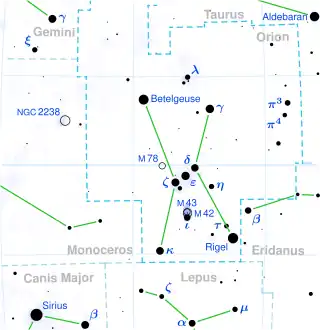WISE J0521+1025
WISE J0521+1025 is a nearby brown dwarf of spectral type T7.5, located in constellation Orion[~ 1] at approximately 5.0 pc (16.3 ly) from Earth.[1]
| Observation data Epoch 2012.773[1] Equinox J2000 | |
|---|---|
| Constellation | Orion |
| Right ascension | 05h 21m 26.349s[1] |
| Declination | 10° 25′ 27.41″[1] |
| Characteristics | |
| Spectral type | T7.5[1] |
| Apparent magnitude (J (2MASS)) | 15.262[1] |
| Apparent magnitude (H (2MASS)) | 15.222 ± 0.103[1] |
| Apparent magnitude (Ks (2MASS)) | 14.665[1] |
| Apparent magnitude (w1 (WISE)) | 14.098 ± 0.031[1] |
| Apparent magnitude (w2 (WISE)) | 12.286 ± 0.026[1] |
| Apparent magnitude (w3 (WISE)) | 10.306 ± 0.085[1] |
| Astrometry | |
| Proper motion (μ) | RA: +232 ± 9[1] mas/yr Dec.: -418 ± 6[1] mas/yr |
| Parallax (π) | 150.2 ± 3.0 mas[2] |
| Distance | 21.7 ± 0.4 ly (6.7 ± 0.1 pc) |
| Other designations | |
| Database references | |
| SIMBAD | data |
 WISE J0521+1025 Location of WISE J0521+1025 in the constellation Orion | |
It is also the nearest known T dwarf in the northern sky.[1]
History of observations
WISE J0521+1025 was discovered by Bihain et al. by selection of sources with colours typical for T dwarfs from WISE All-Sky source catalogue and checking them for high proper motion using older surveys: 2MASS, DENIS, SDSS, SSS, DSS and UKIDSS. Three objects among about ten candidates, including WISE J0521+1025, were selected for spectroscopic follow up with Large Binocular Telescope (LBT). October 9, 2012 Bihain et al. carried out follow up observations of WISE J0521+1025 with near-Infrared spectrograph LUCI 1 on LBT. June 25, 2013 Astronomy & Astrophysics received the discovery paper, which was accepted for publication 10 July 2013.[1]
Distance
Distance of WISE J0521+1025 was estimated by Bihain et al. using mean absolute magnitudes of single T7.5 dwarfs, derived by Dupuy & Liu (2012) from trigonometric parallaxes:[3] 5.0 ± 1.3 pc (16.3 ± 4.2 ly).[1]
See also
Two other T dwarfs, announced in Bihain et al (2013):
- WISE J0457−0207 (T2)
- WISE J2030+0749 (T1.5)
Notes
- It is the nearest known star/brown dwarf in this constellation.
References
- Bihain, Gabriel; Scholz, Ralf-Dieter; Storm, Jesper; Schnurr, Olivier (2013). "An overlooked brown dwarf neighbour (T7.5 at d~5pc) of the Sun and two additional T dwarfs at about 10pc". Astronomy & Astrophysics. 557: A43. arXiv:1307.2722. Bibcode:2013A&A...557A..43B. doi:10.1051/0004-6361/201322141. S2CID 118454396.
- Kirkpatrick, J. Davy; Gelino, Christopher R.; Faherty, Jacqueline K.; Meisner, Aaron M.; Caselden, Dan; Schneider, Adam C.; Marocco, Federico; Cayago, Alfred J.; Smart, R. L.; Eisenhardt, Peter R.; Kuchner, Marc J. (2021). "The Field Substellar Mass Function Based on the Full-sky 20 pc Census of 525 L, T, and y Dwarfs". The Astrophysical Journal Supplement Series. 253 (1): 7. arXiv:2011.11616. Bibcode:2021ApJS..253....7K. doi:10.3847/1538-4365/abd107. S2CID 227126954.
- Dupuy, Trent J.; Liu, Michael C. (2012). "The Hawaii Infrared Parallax Program. I. Ultracool Binaries and the L/T Transition". The Astrophysical Journal Supplement. 201 (2): 19. arXiv:1201.2465. Bibcode:2012ApJS..201...19D. doi:10.1088/0067-0049/201/2/19. S2CID 119256363.